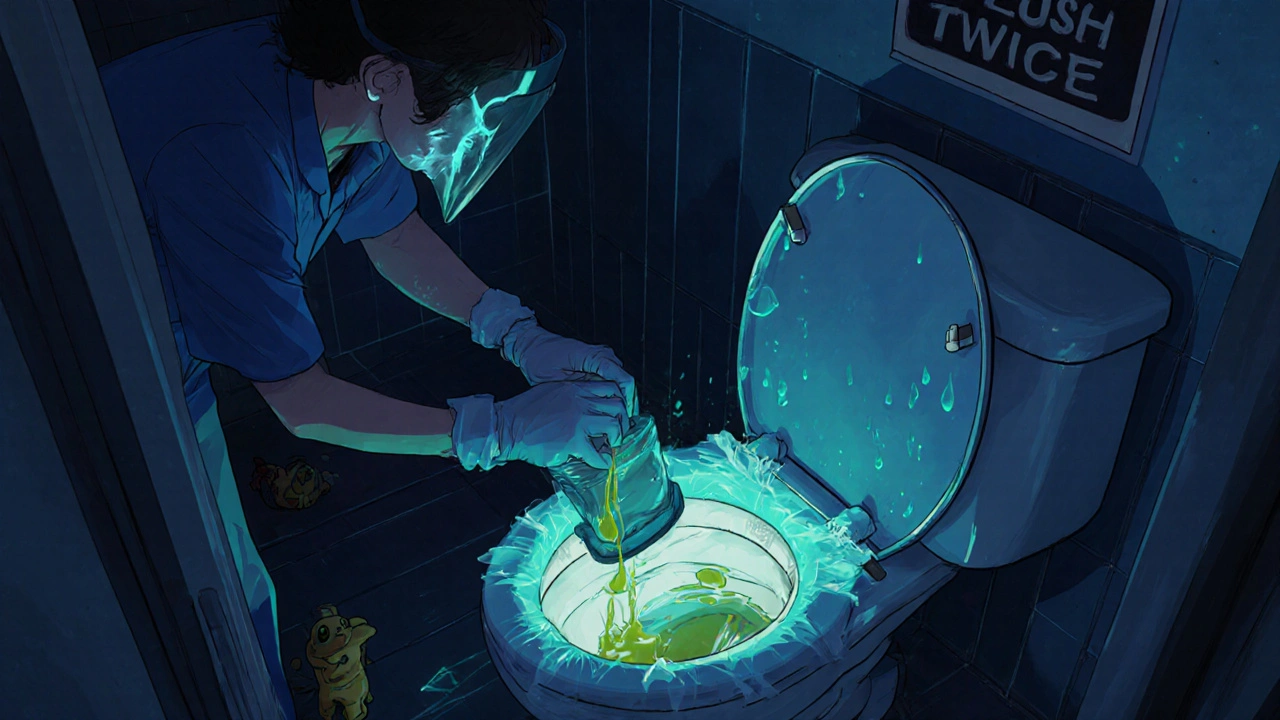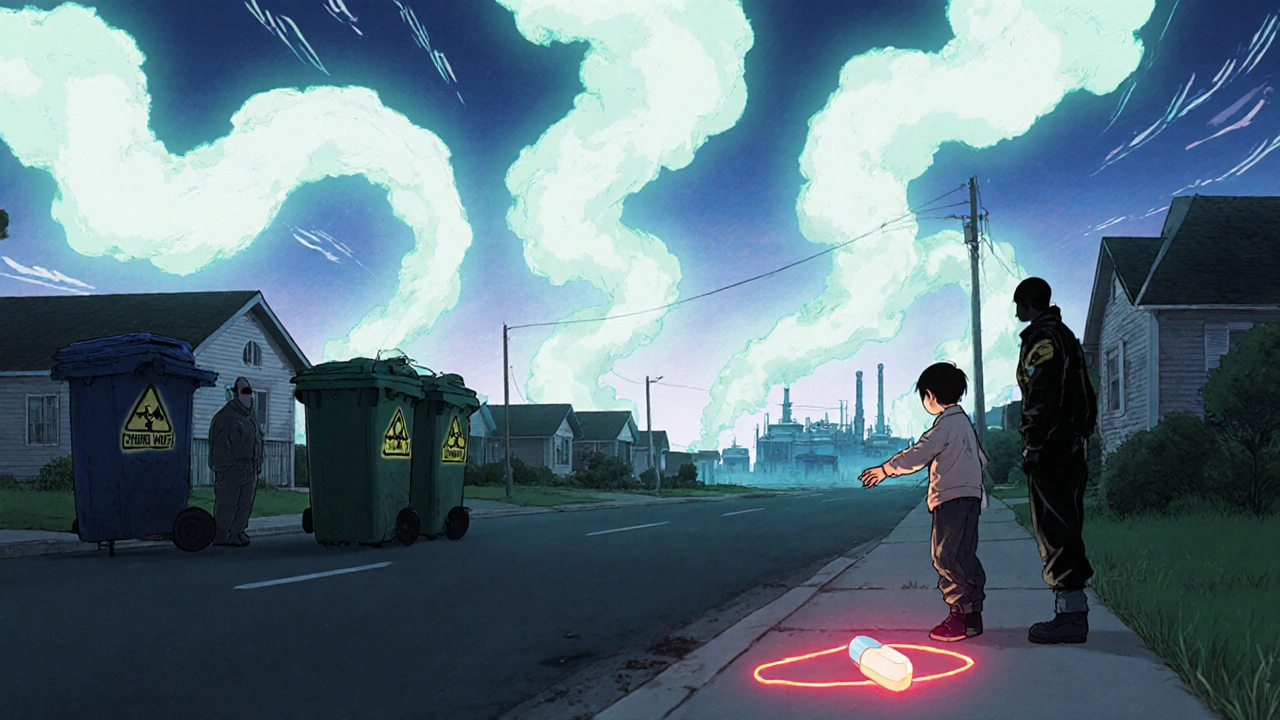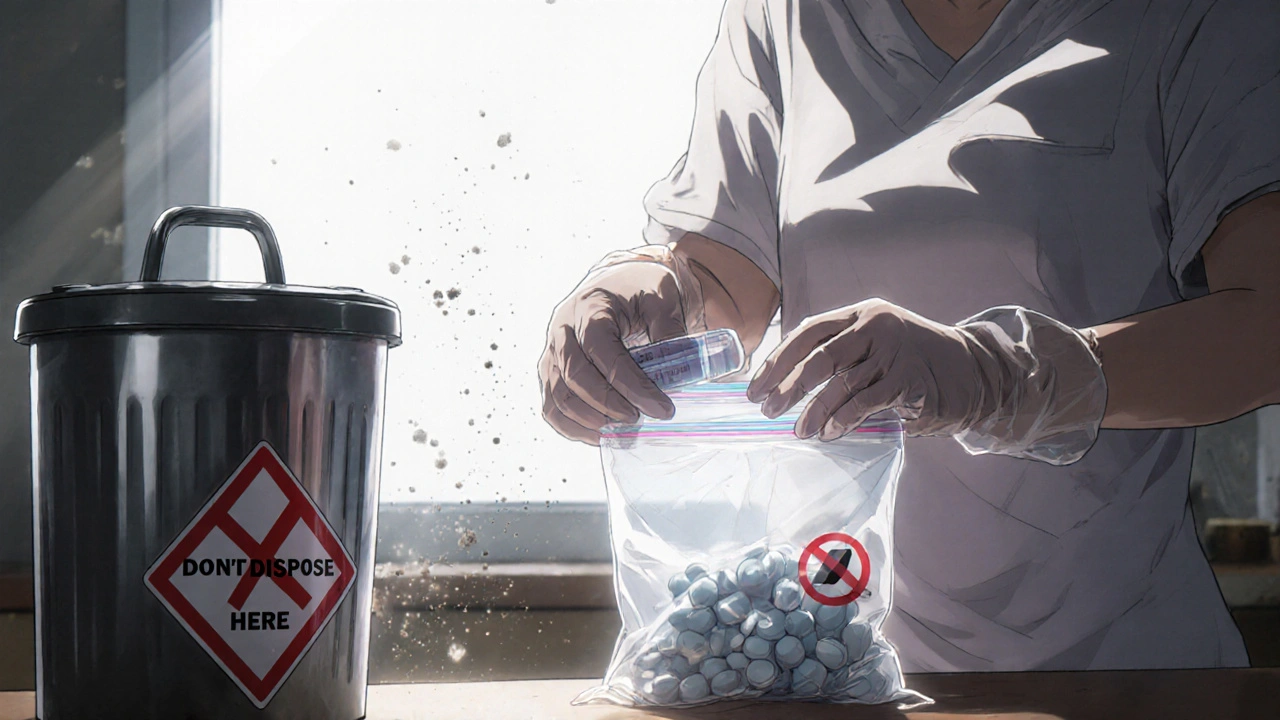Why Chemotherapy Waste Can’t Be Tossed Like Regular Pills
Most people know you shouldn’t flush old pills down the toilet. But when it comes to chemotherapy drugs, the rules are completely different-and far more urgent. These aren’t just strong medications. They’re cytotoxic chemicals designed to kill fast-growing cells, which means they can damage healthy cells too-even through tiny exposures. A single pill, a used glove, or even urine from someone who just took chemo can carry active toxins for days. If you’re getting chemotherapy at home, you’re not just managing your treatment-you’re managing a potential hazard for your family, your trash collectors, and the environment.
What Makes Chemotherapy Drugs So Dangerous to Dispose Of
Unlike regular painkillers or antibiotics, chemotherapy drugs are classified as hazardous waste because they can cause DNA damage, birth defects, and long-term health issues even at low doses. The American Cancer Society says these drugs stay active in bodily fluids-urine, vomit, sweat-for up to 72 hours after treatment. That means if you don’t handle your waste correctly, your partner could get exposed while cleaning the bathroom. Your kids might touch a contaminated glove left on the counter. Even your local wastewater system can end up contaminated. The EPA found detectable levels of cyclophosphamide, a common chemo drug, in 67% of U.S. waterways. That’s not a rumor. That’s science.
What You Must Do When Handling Chemotherapy at Home
Every time you touch a chemo pill, bottle, or syringe, you need to protect yourself. You don’t need a hazmat suit-but you do need the right gear. Always wear disposable nitrile gloves (at least 0.07mm thick) when handling any chemotherapy materials. Regular latex or vinyl gloves won’t cut it-they tear too easily. After you’ve taken your dose, immediately put all used gloves, wipes, and packaging into a sealed plastic bag. Never reuse gloves. Never wash them. Never toss them in the regular trash without double-bagging.
The Double-Bagging Rule: Non-Negotiable
Here’s the one rule that saves lives: double-bag everything. Start with a leak-proof plastic bag (at least 1.5 mil thick) and put all contaminated items inside-pills, empty bottles, used syringes, even tissues you used to wipe your nose after treatment. Seal that bag tightly with a zip-tie or by heat-sealing the top. Then, place that sealed bag inside a second identical bag. Seal it again. This isn’t overkill. Mayo Clinic testing showed this method reduces exposure risk by 92% compared to single-bagging. If you’re using liquid chemo, pour it into a disposable container, mix it with an inert absorbent like cat litter or coffee grounds, then seal it in the first bag before double-bagging. Never crush pills. Never dissolve them. Never flush them. The FDA explicitly bans flushing any chemotherapy drug, even if it’s on the old flush list for opioids or other meds.

What to Do With Transdermal Patches and Liquid Medications
Transdermal patches (like those for oral chemo drugs) are tricky. Don’t just peel them off and throw them in the trash. Fold the patch so the sticky side sticks to itself, then seal it in the inner bag before double-bagging. That prevents accidental skin contact. For liquid medications, always use the container they came in. Never pour them into another bottle. If you spill any liquid chemo, follow the 15-step cleanup protocol from the Cancer Institute of New Jersey: wear gloves, gown, face shield, and mask. Use disposable cloths-never paper towels. Clean the area twice. Seal all cleanup materials in the double-bagged system. Don’t use your regular cleaning supplies. Keep a separate kit for chemo spills.
How Long Do You Keep Taking Precautions?
You can’t just stop being careful after you take your last pill. The body continues to excrete active drugs for 48 to 72 hours after each dose. That means you need to keep double-bagging waste, flushing the toilet twice after use, and washing your hands thoroughly-even if you feel fine. Some patients are told to avoid sharing bathrooms for 72 hours after treatment. If you’re caring for someone on chemo, wear gloves when handling their laundry, bedding, or used tissues. Wash those items separately from the rest of the household laundry. Don’t assume the danger is gone just because the treatment is over.
What You Can’t Use for Disposal
There are a lot of products marketed as “drug disposal solutions,” but most won’t work for chemotherapy. The Deterra® system, which uses activated carbon to neutralize pills, is great for painkillers-but their website clearly states it’s not approved for chemo drugs. MedDrop kiosks, found in some pharmacies, accept only about 63% of chemotherapy medications. And mail-back programs? Only 28% of U.S. pharmacies offer them for chemo waste. Community take-back events? Even fewer-only 12% accept hazardous cancer drugs because of the risk to volunteers and law enforcement. Don’t waste time trying to use these unless your oncology team confirms it’s safe for your specific drug. Most of the time, double-bagging and holding it until you can return it to your provider is your only safe option.

Where to Turn for Help
Your oncology team should give you a disposal kit when you start home treatment. It usually includes gloves, leak-proof bags, and sometimes a special yellow container for hazardous waste. If you run out, ask for replacements. Most providers will send you more at no cost. If they don’t, contact your pharmacy or local cancer support group. The American Cancer Society and Stericycle have partnered to place over 1,800 MedDrop kiosks across 47 states that accept certain chemotherapy waste. Call ahead to confirm your drug is accepted. If you’re unsure, call your oncology nurse. Don’t guess. Don’t risk it.
What Happens If You Don’t Follow the Rules
Improper disposal isn’t just irresponsible-it’s dangerous. Stericycle’s 2022 report found that 41% of patients handling chemo at home dispose of it incorrectly. That’s more than 2 in 5 people. The consequences? Nurses and waste workers get exposed. Pets and children come into contact with toxic residue. Water supplies get contaminated. In one documented case, a child developed a rare blood disorder after touching a chemo pill that had been flushed and settled in a home’s drain. That’s not theoretical. That’s real. And it’s preventable.
What’s Changing in 2025
The rules are getting tighter. In March 2023, the FDA required all oral chemotherapy drugs to include clear disposal instructions on their labels. That affects 147 drugs worth over $8 billion in annual sales. The EPA is spending $4.7 million between 2022 and 2026 to find better ways to stop pharmaceutical pollution from homes. Two new disposal systems-ChemiSafe and the Oncology Waste Management Unit-are in final testing and could be available soon. But until then, the only proven method is double-bagging, wearing gloves, and following your provider’s instructions exactly. Don’t wait for new tech. Use what works now.
How to Stay on Track
Most patients need more than one training session to get this right. CancerCare’s 2022 survey found 68% of patients needed repeated coaching from nurses. Keep a checklist taped to your fridge: gloves on? Double-bagged? Sealed? Flushed twice? Don’t rely on memory. If your provider’s instructions are unclear, ask for a printed version. Memorial Sloan Kettering scores 9.2 out of 10 for clear disposal guidance. Many others score below 7. If yours is vague, push for better. You’re not being difficult-you’re protecting your family.

Holly Powell
November 17, 2025 AT 13:32Let’s be clear: the cytotoxic load from home-based chemo waste is a systemic failure of pharmaceutical regulation. The EPA’s detection of cyclophosphamide in 67% of U.S. waterways isn’t incidental-it’s a biomarker of institutional negligence. Double-bagging is a band-aid on a hemorrhage. We need federally mandated neutralization protocols, not glorified Ziploc solutions. The FDA’s 2023 labeling mandate is performative compliance. Where’s the liability for manufacturers who design drugs that persist in aquatic ecosystems? This isn’t patient education-it’s environmental triage.
Emanuel Jalba
November 18, 2025 AT 11:25THIS IS WHY WE CAN’T HAVE NICE THINGS 😭 I JUST FOUND OUT MY NEIGHBOR FLUSHED HER CHemo PILL AND NOW MY DOG IS SICK 🐶💔 I’M NOT JOKING. I SAW THE DOCTOR. SHE SAID IT COULD BE TOXIC EXPOSURE. PEOPLE AREN’T TRYING TO KILL THEIR FAMILIES BUT THEY JUST DON’T GET IT. #CHEMOWASTEISNOTTRASH #DONTFLUSHMYLIFE
Shilpi Tiwari
November 20, 2025 AT 00:56Interesting data on the EPA’s detection rates-but what’s the pharmacokinetic half-life of these agents in wastewater treatment plants? Are we accounting for bioaccumulation in aquatic flora? The 92% risk reduction from double-bagging sounds compelling, but without quantitative exposure thresholds (LD50, LC50), we’re operating on heuristic safety, not evidence-based toxicology. Has any peer-reviewed study correlated household chemo disposal with pediatric leukemia incidence in adjacent ZIP codes? I’d love to see the cohort analysis.
Christine Eslinger
November 21, 2025 AT 16:23I’ve been a nurse for 18 years, and I’ve seen families panic over this exact issue. The truth? Most people aren’t careless-they’re terrified and overwhelmed. The double-bagging rule isn’t just protocol-it’s love in action. When you seal that second bag, you’re not just protecting trash collectors. You’re saying to your kid, ‘I won’t let this hurt you.’ You’re telling your partner, ‘I see you cleaning up after me.’ This isn’t about rules. It’s about holding space for someone who’s fighting to live. And if your provider doesn’t give you a kit? Ask again. And again. You deserve better.
Denny Sucipto
November 22, 2025 AT 00:36Man, I just had my wife go through chemo last year. We did the double-bagging thing like you said-gloves, sealed, twice, even the cat litter trick. Honestly? It felt weird at first. Like we were living in a sci-fi movie. But then I thought-this ain’t about being extra, it’s about being alive. My daughter still hugs me after I get home from work. I don’t want her to pay for this later. So yeah, I’ll keep sealing those bags like my life depends on it… because honestly? It kinda does.
Katelyn Sykes
November 22, 2025 AT 16:53Double bagging works but why the hell are we still using plastic? Like seriously. We’re saving lives but wrecking the planet. Anybody else think we need biodegradable chemo bags? Or maybe a national return program? I’m just saying. Also I flush twice now. Always. No questions.
Gabe Solack
November 23, 2025 AT 21:18Just wanted to say thank you for this post. My mom’s on chemo and I used to toss her gloves in the regular trash. Now I’ve got a whole system set up-gloves, bags, labels, even a little bin under the sink. I didn’t realize how much I didn’t know until I read this. You saved my family from a nightmare. 🙏
Yash Nair
November 24, 2025 AT 23:43USA so weak. In India we just burn it. No plastic. No bags. No drama. Waste goes to incinerator. Simple. Efficient. No crying over gloves. Why are you all so soft? This is cancer not a tea party. You think your plastic bags protect the world? HA. We kill the poison. Not hide it.
Bailey Sheppard
November 26, 2025 AT 13:38Thank you for writing this. I’ve been helping a friend through treatment and I didn’t know any of this. I thought flushing was bad, but I had no idea it was this serious. I’m sharing this with everyone I know. We need more of these clear, calm, factual posts. Not fear. Just facts. And care.
Girish Pai
November 28, 2025 AT 06:14Indian hospitals handle this better than US. We have centralized hazardous waste units. No one flushes. No one double bags. We have trained staff. You Americans overcomplicate everything. Plastic bags? Cat litter? Are you kidding me? We incinerate. Period. This is why your waste systems are broken. You need discipline. Not more plastic.
Kristi Joy
November 29, 2025 AT 13:13If you’re reading this and you’re scared you’re doing it wrong-you’re not alone. I’ve been there. I cried the first time I sealed that second bag. But you’re not failing. You’re showing up. And that’s enough. If you need a checklist, I made one. DM me. I’ll send it. No judgment. Just support.
Hal Nicholas
November 29, 2025 AT 20:23Let’s be honest-this whole system is a scam. The pharma companies make billions. They know these drugs linger. They know the EPA data. But they don’t want you to know the real cost. Double-bagging? That’s just a distraction. The real solution? Ban these drugs. Or make the manufacturers pay for safe disposal. Not the patient. Not the nurse. Not the trash worker. THEM.
Louie Amour
November 30, 2025 AT 07:07Oh wow. So now I’m supposed to be a hazmat technician just because I’m getting cancer? This is ridiculous. Who wrote this? Some corporate compliance drone? I’m not a scientist. I’m a person trying to survive. You want me to wear gloves? Fine. But don’t act like I’m the problem. The problem is a system that gives me poison and then makes me clean up after it.
Kristina Williams
November 30, 2025 AT 09:25They’re lying. The government knows chemo stays active for 14 days not 72. They’re hiding it. I read a whistleblower blog. They’re testing this on the poor. The water is poisoned. The pets are dying. The kids are getting sick. They don’t want you to know. That’s why they push double-bagging-it keeps you busy while they poison the rivers. Look up Project SafeTreat. It’s all connected.